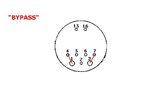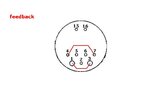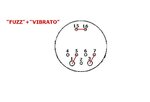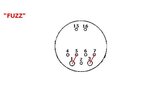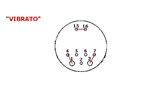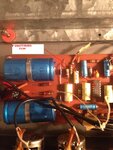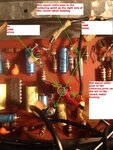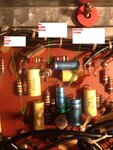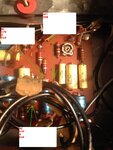waltom
Newbie level 4
Hi,
recently I bought the vintage Elka Reverb effect III. Unfortynately there's no documentation on the internet, no schematics, nothing...
I bought it without a pedal that activates the individual sections: REVERB / VIBRATO / FUZZ
By trying different combinations (by connecting the pins in the back socket) I managed to run VIBRATO, FUZZ and BYPASS. But I can not figure out what combination turns on REVERB.
Below you can find photo of "guts" with the description where every PIN is connected on board. I send also photos of combinations of connections, which turns on bypass, vibrato, fuzz and some kind of un-controlled feedback.
Whether on the basis of this information could someone who is the subject of audio write what combination should TURN ON REVERB?
If nothing is connected to the socket, you can hear the reverb, but the signal is sooooo quiet.
With the combination "vibrato" "fuzz" "bypass" the signal is loud (normal) but there is no reverb.
PIN OUT is:
1 - two wires are soldered to this pin. First goes to the TIP of INPUT JACK, the other goes to the board
2 - grounding
3 - to the board,
4 - to the board,
5 - to the board,
6 - grounding
7 - goes to the TIP of OUTPUT JACK,
15 - to the board,
16 - to the board.


Thanks in advance for your help
Regards,
Tomek
recently I bought the vintage Elka Reverb effect III. Unfortynately there's no documentation on the internet, no schematics, nothing...
I bought it without a pedal that activates the individual sections: REVERB / VIBRATO / FUZZ
By trying different combinations (by connecting the pins in the back socket) I managed to run VIBRATO, FUZZ and BYPASS. But I can not figure out what combination turns on REVERB.
Below you can find photo of "guts" with the description where every PIN is connected on board. I send also photos of combinations of connections, which turns on bypass, vibrato, fuzz and some kind of un-controlled feedback.
Whether on the basis of this information could someone who is the subject of audio write what combination should TURN ON REVERB?
If nothing is connected to the socket, you can hear the reverb, but the signal is sooooo quiet.
With the combination "vibrato" "fuzz" "bypass" the signal is loud (normal) but there is no reverb.
PIN OUT is:
1 - two wires are soldered to this pin. First goes to the TIP of INPUT JACK, the other goes to the board
2 - grounding
3 - to the board,
4 - to the board,
5 - to the board,
6 - grounding
7 - goes to the TIP of OUTPUT JACK,
15 - to the board,
16 - to the board.


Thanks in advance for your help
Regards,
Tomek
Attachments
Last edited by a moderator:
